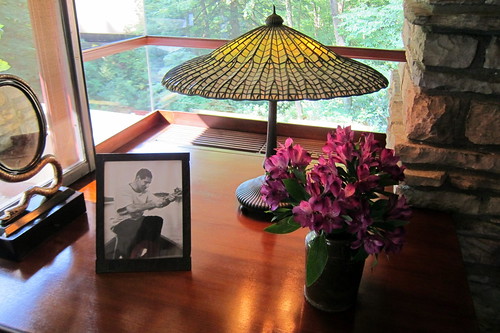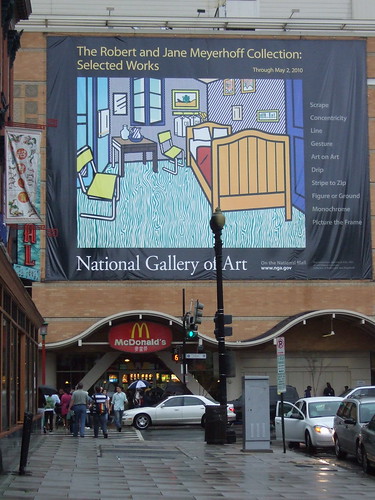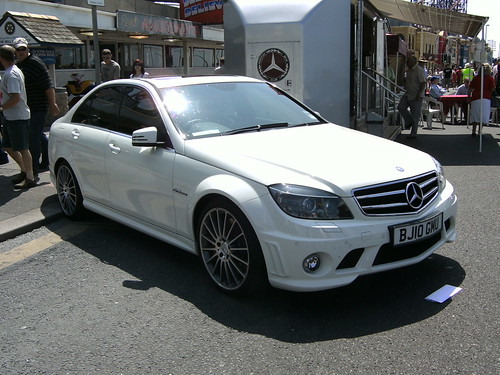PA - Mill Run: Fallingwater Master Bedroom desk
Image by wallyg
A Tiffany Lotus Leaf Lamp and a Tiffany frame, located on the desk in Fallingwater's master bedroom, are two of the many Tiffany objects collected by the Kaufmanns and displayed in the house. The lamp has a bronze base, and a shade comprised of glass panes in various shades of green and yellow set into a leaded leaf-vein motif. The Green Lotus leaf shade, probably designed between 1902 and 1914 by a Tiffany Studio designer and approved by Louis Comfort Tiffany himself, is often considered a transition between the decidedly more geometric designs and predominantly floral shades. The 12¼" x 9¾" bronze picture frame, featuring a variation of the Green key design in all four corners, dates to the early 20th century. The Kaufmanns had an important collection of Tiffany, largely purchased from the Lillian Nassau Studios in New York, and donated many pieces to the Museum of Modern Art.
The Fallingwater master bedroom, at the center of the second floor, was Liliane Kaufmann's bedroom. The balcony from the master bedroom forms the external highlight of the house.
Fallingwater, sometimes referred to as the Edgar J. Kaufmann Sr. Residence or just the Kaufmann Residence, located within a 5,100-acre nature reserve 50 miles southeast of Pittsburgh, was designed by Frank Lloyd Wright and built between 1936 and 1939. Built over a 30-foot flowing waterfall on Bear Run in the Mill Run section of Stewart Township, Fayette County, Pennsylvania, the house served as a vacation retreat for the Kaufmann family including patriarch, Edgar Kaufmann Sr., was a successful Pittsburgh businessman and president of Kaufmann's Department Store, and his son, Edgar Kaufmann, Jr., who studied architecture briefly under Wright. Wright collaborated with staff engineers Mendel Glickman and William Wesley Peters on the structural design, and assigned his apprentice, Robert Mosher, as his permanent on-site representative throughout construction. Despite frequent conflicts between Wright, Kaufmann, and the construction contractor, the home and guesthouse were finally constructed at a cost of 5,000.
Fallingwater was designated a National Historic Landmark in 1966. It was listed among the Smithsonian's 28 Places to See Before You Die. In a 1991 poll of members of the American Institute of Architects (AIA), it was voted "the best all-time work of American architecture." In 2007, Fallingwater was ranked #29 on the AIA 150 America's Favorite Architecture list.
National Register #74001781 (1974)
PA - Mill Run: Fallingwater Master Bedroom desk
Image by wallyg
A Tiffany Lotus Leaf Lamp and a Tiffany frame, located on the desk in Fallingwater's master bedroom, are two of the many Tiffany objects collected by the Kaufmanns and displayed in the house. The lamp has a bronze base, and a shade comprised of glass panes in various shades of green and yellow set into a leaded leaf-vein motif. The Green Lotus leaf shade, probably designed between 1902 and 1914 by a Tiffany Studio designer and approved by Louis Comfort Tiffany himself, is often considered a transition between the decidedly more geometric designs and predominantly floral shades. The 12¼" x 9¾" bronze picture frame, featuring a variation of the Green key design in all four corners, dates to the early 20th century. The Kaufmanns had an important collection of Tiffany, largely purchased from the Lillian Nassau Studios in New York, and donated many pieces to the Museum of Modern Art.
The Fallingwater master bedroom, at the center of the second floor, was Liliane Kaufmann's bedroom. The balcony from the master bedroom forms the external highlight of the house.
Fallingwater, sometimes referred to as the Edgar J. Kaufmann Sr. Residence or just the Kaufmann Residence, located within a 5,100-acre nature reserve 50 miles southeast of Pittsburgh, was designed by Frank Lloyd Wright and built between 1936 and 1939. Built over a 30-foot flowing waterfall on Bear Run in the Mill Run section of Stewart Township, Fayette County, Pennsylvania, the house served as a vacation retreat for the Kaufmann family including patriarch, Edgar Kaufmann Sr., was a successful Pittsburgh businessman and president of Kaufmann's Department Store, and his son, Edgar Kaufmann, Jr., who studied architecture briefly under Wright. Wright collaborated with staff engineers Mendel Glickman and William Wesley Peters on the structural design, and assigned his apprentice, Robert Mosher, as his permanent on-site representative throughout construction. Despite frequent conflicts between Wright, Kaufmann, and the construction contractor, the home and guesthouse were finally constructed at a cost of 5,000.
Fallingwater was designated a National Historic Landmark in 1966. It was listed among the Smithsonian's 28 Places to See Before You Die. In a 1991 poll of members of the American Institute of Architects (AIA), it was voted "the best all-time work of American architecture." In 2007, Fallingwater was ranked #29 on the AIA 150 America's Favorite Architecture list.
National Register #74001781 (1974)
PA - Mill Run: Fallingwater Master Bedroom desk
Image by wallyg
A Tiffany Lotus Leaf Lamp and a Tiffany frame, located on the desk in Fallingwater's master bedroom, are two of the many Tiffany objects collected by the Kaufmanns and displayed in the house. The lamp has a bronze base, and a shade comprised of glass panes in various shades of green and yellow set into a leaded leaf-vein motif. The Green Lotus leaf shade, probably designed between 1902 and 1914 by a Tiffany Studio designer and approved by Louis Comfort Tiffany himself, is often considered a transition between the decidedly more geometric designs and predominantly floral shades. The 12¼" x 9¾" bronze picture frame, featuring a variation of the Green key design in all four corners, dates to the early 20th century. The Kaufmanns had an important collection of Tiffany, largely purchased from the Lillian Nassau Studios in New York, and donated many pieces to the Museum of Modern Art.
The Fallingwater master bedroom, at the center of the second floor, was Liliane Kaufmann's bedroom. The balcony from the master bedroom forms the external highlight of the house.
Fallingwater, sometimes referred to as the Edgar J. Kaufmann Sr. Residence or just the Kaufmann Residence, located within a 5,100-acre nature reserve 50 miles southeast of Pittsburgh, was designed by Frank Lloyd Wright and built between 1936 and 1939. Built over a 30-foot flowing waterfall on Bear Run in the Mill Run section of Stewart Township, Fayette County, Pennsylvania, the house served as a vacation retreat for the Kaufmann family including patriarch, Edgar Kaufmann Sr., was a successful Pittsburgh businessman and president of Kaufmann's Department Store, and his son, Edgar Kaufmann, Jr., who studied architecture briefly under Wright. Wright collaborated with staff engineers Mendel Glickman and William Wesley Peters on the structural design, and assigned his apprentice, Robert Mosher, as his permanent on-site representative throughout construction. Despite frequent conflicts between Wright, Kaufmann, and the construction contractor, the home and guesthouse were finally constructed at a cost of 5,000.
Fallingwater was designated a National Historic Landmark in 1966. It was listed among the Smithsonian's 28 Places to See Before You Die. In a 1991 poll of members of the American Institute of Architects (AIA), it was voted "the best all-time work of American architecture." In 2007, Fallingwater was ranked #29 on the AIA 150 America's Favorite Architecture list.
National Register #74001781 (1974)
National Gallery of Art_Exhibit of Meyerhoff Collection
Image by catface3
www.nga.gov/exhibitions/meyerhoffinfo.shtm
Ten themes—Scrape, Concentricity, Line, Gesture, Art on Art, Drip, Stripe to Zip, Figure or Ground, Monochrome, and Picture the Frame—illuminate specific works across the Robert and Jane Meyerhoff Collection. The resulting juxtapositions, often surprising and provocative, provide a new way to tell the story of postwar American art, and of a great collection. Through remarkable acuity, exhaustive study, and close relationships with the artists, the Meyerhoffs amassed one of the most outstanding collections of modern art, with an emphasis on six American masters: Jasper Johns, Ellsworth Kelly, Roy Lichtenstein, Brice Marden, Robert Rauschenberg, and Frank Stella, in addition to important works by leading abstract expressionists and younger artists. A number of the ten themes concern the material process of creation, others address issues of form and composition, and still others extend past material and formal issues to broach the self-reflexive aspects of modernist painting. Some 126 paintings, sculptures, drawings, and prints include several acquisitions made after the collection was last highlighted in a major exhibition at the Gallery in 1996. All of the works in the exhibition have been donated or promised to the National Gallery of Art and continue to shape and greatly enhance the Gallery's modern and contemporary collection.
Sponsor: This exhibition is supported by an indemnity from the Federal Council on the Arts and the Humanities.
Schedule: National Gallery of Art, October 1, 2009–May 2, 2010
The exhibition is on view in the National Gallery's East Building, Upper Level and Mezzanine.
Modern Mercedes Benz
Image by friskierisky
No comments:
Post a Comment